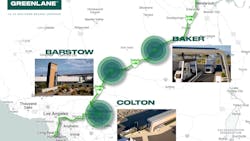Greenlane to establish 280-mile EV charging corridor
Greenlane, the joint venture between Daimler Truck North America, NextEra Energy Resources, and BlackRock, is producing its first commercial EV charging corridor. The chain of installations will feature over 100 chargers accompanied by rest stations with driver amenities.
“After considering various factors, such as truck telematics data, frequent freight routes and customer deployment strategy, the Greenlane team selected these three optimal locations for our first commercial charging corridor to accelerate the transition to zero emissions,” said Patrick Macdonald-King, CEO of Greenlane. “The launch of this corridor not only marks a critical step in addressing the urgent need for publicly available, nationwide electric charging for commercial vehicles but will also serve as a model for the EV charging hubs of the future.”
The corridor will follow Interstate 15 and include locations in Colton, Barstow, and Baker, California. Additional locations beyond Southern Nevada and into San Pedro, California, will be added over the next year.
Read more: DTNA, Navistar, Volvo Trucks partner on zero-emission coalition
Greenlane is working to break ground on the inaugural Colton site in spring 2024 and open the flagship site later that same year. Located at the intersection of Interstates 10 and 215, the Colton charging site will offer 60 chargers, including 400 kW Direct Current Fast Chargers (DCFC) to quickly charge medium- and heavy-duty zero-emissions vehicles. The site will also feature 200kW DCFC charging options for long-duration and overnight charging for heavy-duty tractors, medium-duty ZEVs, and school buses. Charging options for passenger cars and light-duty vehicles will be offered as well. Eventually, long-duration and overnight charging for tractor-trailer combinations will be available, and the site will be able to accommodate the Megwatt Charging System when it is available, the company stated.
"By using a predictive modeling tool to simulate truck traffic and energy flow at the site, we can determine how many chargers are necessary to meet the regional demand based on vehicle characteristics and departure and arrival times for vehicles hauling freight along this corridor," said Macdonald-King. "Our findings indicated that placing the three stations approximately 60 to 90 miles apart would maximize uptime for day-cab drivers by enabling shorter charging sessions at each stop and ultimately allowing customers to move freight confidently without any limitations."
Beyond the Colton location, each site will have wide pull-through lanes, restrooms, and food and beverage options for drivers. The corridor also hopes to offer hydrogen refueling options for commercial vehicles in coming years as well.

